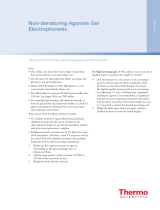
TopVision Low Melting Point Agarose
Catalog Number R0801
Pub. No. MAN0013156 Rev. B.00
Contents and storage
Cat. No.
Contents
Amount
Storage
R0801
TopVision Low Melting Point Agarose
25 g
15 °C to 25 °C
Description
Thermo Scientific TopVision Low Melting Point Agarose is highly purified agarose with a low melting temperature
certified by strict quality control test procedures.
Characteristics
Electroendosmosis (EEO) < 0.12
Gel strength (1.5 % gel), g/cm2 > 500
Gel point (1.5 % gel) 26 ± 2 °C
Melting point (1.5 % gel) < 65.5 °C
Moisture < 10 %
Ash < 4 %
Applications
Preparation of DNA preparative gels in routine molecular biology techniques.
In-gel enzymatic processing (digestion, ligation etc.).
The DNA recovered from agarose gels after electrophoresis can be used in enzymatic process (restriction, ligation,
etc.) (1).
Digestion of re-melted agarose by agarase enzymes makes it very easy to recover large DNA fragments suitable
for cloning or enzymatic processing.
May be used at concentrations between 0.8 - 2.0 % with typical buffer systems.
Protocol for recovery of DNA from TopVision™ Low Melting Point Agarose gels using Agarase (#E00461)
I. Agarose digestion
1. Perform electrophoresis of DNA in a low melting agarose gel prepared in TAE, 0.5X TBE, TBE or TPE buffer.
Stain the gel with ethidium bromide.
2. Cut out the desired band from the agarose gel with a clean, nuclease free spatula. Limit UV exposure of the gel
slice to a minimum. Cut out as much agarose as is necessary to recover the DNA band.
3. Place the gel slice into a pre-weighed 1.5 mL microcentrifuge tube and determine the weight of the slice. To
facilitate melting, cut gel slices larger than 200 mg into smaller pieces.
4. Incubate the tube for approx. 10 min at 70 °C until the agarose is completely melted.
For Research Use Only. Not for use in diagnostic procedures.
WARNING! Read the Safety Data Sheets (SDSs) and follow the handling instructions. Wear appropriate protective eyewear, clothing, and gloves. Safety Data
Sheets (SDSs) are available from thermofisher.com/support..

Note
Incubation at elevated temperatures may denature DNA.
Ensure that the gel slice is thoroughly melted. If the agarose is
not completely melted, the hydrolysis also will be incomplete.
5. Transfer the tube to a 42 °C water bath and equilibrate
for 5 min prior to adding Agarase.
6. Add 1 unit of Agarase per 100 mg (approx. 100 µL) of
1 % agarose; gently mix and incubate for 30 min at 42 °C.
Note
If you are using a higher percentage agarose, the amount of
Agarase should be proportionately increased.
II. DNA purification
DNA fragments larger than 30 kb
Large DNA fragments require delicate handling to avoid
mechanical shearing.
1. Centrifuge at 15000 g for 10 min to pellet undigested
carbohydrates.
2. Remove oligosaccharides and Agarase by dialysis or
carry out subsequent manipulations with DNA in the
digested agarose solution.
DNA fragments smaller than 30 kb
1. Add salt to hydrolyzed agarose: ammonium acetate to
2.5 M or sodium acetate to 0.3 M.
Note
Use ammonium acetate rather than other salts, because they
may cause co-precipitation of oligosaccharides with DNA.
T4 polynucleotide kinase is inhibited by ammonium ions. Use
sodium acetate if, following recovery, you will be labeling
5’-ends of DNA with T4 polynucleotide kinase.
2. Chill on ice for 5 min, centrifuge at 15000 g for 10 min
to pellet undigested carbohydrates.
3. Transfer the supernatant to a clean tube. Add 1 volume of
isopropanol or 2-3 volumes of ethanol, mix gently and
incubate at least for 30 min at 0 °C to 22 °C.
Note
If DNA fragments are <500 bp or if DNA concentration is <0.05
µg/mL, incubate overnight at 0 °C to 22 °C.
4. Centrifuge at 15000 g for 15 min, remove supernatant
and dry pellet. The pellet can be resuspended in an
appropriate buffer for subsequent manipulation.
Fig. 1. Electrophoresis of DNA size markers.
1 % TopVision Low Melting Point Agarose, 1X TAE.
1 – Thermo Scientific GeneRuler DNA Ladder Mix
2 – GeneRuler™ 100 bp DNA Ladder Plus
3 – GeneRuler DNA Ladder Mix, ready-to-use
4 – GeneRuler 1 kb DNA Ladder
5 – Thermo Scientific MassRuler DNA Ladder, High Range, ready-to-use
6 – GeneRuler 100 bp DNA Ladder
Reference
1. Current Protocols in Molecular Biology (Ausubel, F.M., ed.),
John Wiley & Sons, Inc., Brooklyn, New York, 2.6.5-2.6.7, 1999.
Limited product warranty
Life Technologies Corporation and/or it affiliate(s) warrant their products as set forth in the Life Technologies’ General Terms and Conditions
of Sale at www.thermofisher.com/us/en/home/global/terms-and-conditions.html. If you have any questions, please contact Life
Technologies at www.thermofisher.com/support.
The information in this guide is subject to change without notice.
DISCLAIMER: TO THE EXTENT ALLOWED BY LAW, THERMO FISHER SCIENTIFIC INC. AND/OR ITS AFFILIATE(S) WILL NOT BE LIABLE FOR SPECIAL, INCIDENTAL, INDIRECT,
PUNITIVE, MULTIPLE, OR CONSEQUENTIAL DAMAGES IN CONNECTION WITH OR ARISING FROM THIS DOCUMENT, INCLUDING YOUR USE OF IT.
Important Licensing Information: These products may be covered by one or more Limited Use Label Licenses. By use of this product, you accept the terms and conditions of all
applicable Limited Use Label Licenses.
©2019 Thermo Fisher Scientific Inc. All rights reserved. All trademarks are the property of Thermo Fisher Scientific and its subsidiaries unless otherwise specified.
hermofisher.com/support | thermofisher.com/askaquestion
thermofisher.com
Thermo Fisher Scientific Baltics UAB | V.A. Graiciuno 8, LT-02241 Vilnius, Lithuania
For descriptions of symbols on product labels or product documents, go to thermofisher.com/symbols-definition.
30 October 2019
/









